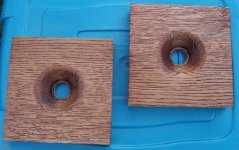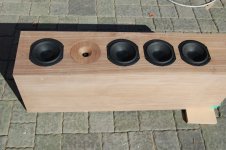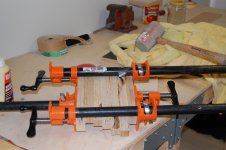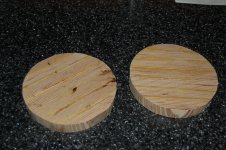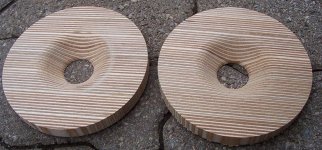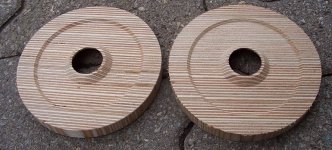Another question for those in the states, what are you using for dampening material?
I saw the MCM link for the wool/Dacron bats, but I was hoping to source something local as well as something that supports larger contiguous sections.
I know Dow had a polyester insulation called soft touch a few years back, but, it seems to be discontinued. The market appears to be in wrapped fiberglass (great for homeowners, not so much for speakers).
Ideas? Thanks.
I saw the MCM link for the wool/Dacron bats, but I was hoping to source something local as well as something that supports larger contiguous sections.
I know Dow had a polyester insulation called soft touch a few years back, but, it seems to be discontinued. The market appears to be in wrapped fiberglass (great for homeowners, not so much for speakers).
Ideas? Thanks.
I used the MCM product, found at Acoustic Dampening Pad | LS00916 | Distributed By MCM
I bought four of the small rolls, about $30. Had just a little left over. It is obviously the right material as it sounds right, just the way the directions say, no experimenting necessary. I know it seems expensive compared to the pink stuff, but my suggestion is to use what you know will work. I find it is a lot cheaper in the long run, especially with $4 gas, to let the internet do the "walking".
I bought four of the small rolls, about $30. Had just a little left over. It is obviously the right material as it sounds right, just the way the directions say, no experimenting necessary. I know it seems expensive compared to the pink stuff, but my suggestion is to use what you know will work. I find it is a lot cheaper in the long run, especially with $4 gas, to let the internet do the "walking".
Thanks tpate.
The cost is not the issue, nor is buying online. Fiberglass was never seriously in consideration. I was just looking for a local alternative to support the local economy. I try to do that when practical. Plus, you never know where that local contact will lead. I met some great folks and discovered some amazing capability hunting down my cabinet material.
In any case, if no one else chimes in, that will most certainly be my path forward.
The cost is not the issue, nor is buying online. Fiberglass was never seriously in consideration. I was just looking for a local alternative to support the local economy. I try to do that when practical. Plus, you never know where that local contact will lead. I met some great folks and discovered some amazing capability hunting down my cabinet material.
In any case, if no one else chimes in, that will most certainly be my path forward.
Dow "Safe Touch". It's being sold here in Columbus as a "test market" I guess. My friend with the speaker company uses it for a particular application in his speakers (not just that though, there are a couple other materials he also uses). I buy it for him here in Columbus and ship it to him in Brooklyn....I know Dow had a polyester insulation called soft touch a few years back, but, it seems to be discontinued. The market appears to be in wrapped fiberglass (great for homeowners, not so much for speakers)..
Dow "Safe Touch". It's being sold here in Columbus as a "test market" I guess. My friend with the speaker company uses it for a particular application in his speakers (not just that though, there are a couple other materials he also uses). I buy it for him here in Columbus and ship it to him in Brooklyn.
Which stores in Ohio stock it?
They have some at the Broad Street store. I think it's only in Columbus. Some other Columbus stores may also have it, but that was the one close to me which still had some in stock. The one nearest to where I live stopped carrying it.
They said "because they always sold out of it, they stopped carrying it". Seems silly to me, just ask for MORE??? I thought that's the point of having a store, right, to SELL stuff? Maybe the clerk I was talking to just wasn't the best at communication - maybe he meant that they couldn't get much to stock so they decided not to bother selling it anymore...
They said "because they always sold out of it, they stopped carrying it". Seems silly to me, just ask for MORE??? I thought that's the point of having a store, right, to SELL stuff? Maybe the clerk I was talking to just wasn't the best at communication - maybe he meant that they couldn't get much to stock so they decided not to bother selling it anymore...
Last edited:
Just want to point out that 2uF is what I ended up recommending, but I do also recommend that some experimentation with that value is worthwhile and also to share and provide feedback.
The reason: The Waveguide makes even small changes to the 2uF much more noticeable than without it, maybe not an exxageration to say that it may makes as much as three times more noticeable. So changing from say 2 to 2.2uF is only a change of 0.2uF, but sonically may have the effect of 0.5uF or 0.6uF under other circumstances.
The reason is that the Waveguide's "gain" is controlled by the value of this cap.
So even tweaking this value in 0.1uF increments may be worthwhile, but if you try it, share it with the rest of us.
Cheers, Joe
PS: Thanks ptate for a short concise 'review' - very nice.
As per your prompt, I've changed from my original 2uf to a 1.8uf Jantzen Audio Superior Z-Cap, and there is remarkable difference. In particular, recordings of the "lesser quality" , ie those not considered audiophile type, are more pleasent to the ear with both an improvment in the dynamics in the bass/mid range while attenuating the top end slightly- without loosing clarity. On that point, the clarity has improved somewhat dramatically with the reference (audiophile) tracks I used to differentiate between the caps- difficult for me to explain, but there seems to be an improved "harmonics quality"- in particular, certain piano passages now sound amazingly different. In summary, I'm extremely happy and amazed with the change so far. For me, its the sound Im after.
For what its worth, I reccommend the experimentation and the Jantzen cap
Waveguide Purchase 2 Invitation
I have one pair of Aluminum Waveguides for my speakers.
Notice 2 small changes:
The rear pocket finishes with a taper to alow for one set-up in the lathe.
The screw holes are moved close to the outside.
This pair was machined in a way that I will now use clear Powder coat for this pair but can paint a batch black as well. Personal taste here.
Note: There has been inquires. Maybe some, understanably, dont read all the posts but I need 5 pairs paid up front to make it work. $160can/pair
I can wait until the end of next week(June 5) if anyone is interested. The machinist can start the following week.
Joel
so Joel , just to clarify , is that for one pair powdercoated black ? and shipping to the USA ?
yes i want a pair .
cheers Woody
WAVEGUIDE PURCHASE DETAILS
WAVEGUIDE Machining Starts June 6.
Painted following week. Colour is Black like that on post 804
Price: $80 Canadian dollars for each Waveguide or 160/pair. Must receive money no later than June 5 at day's end. Paypal preffered
Shipping is extra and pay actual shipping cost at that time.
Please send private message through this forum
Thanks, Joel
WAVEGUIDE Machining Starts June 6.
Painted following week. Colour is Black like that on post 804
Price: $80 Canadian dollars for each Waveguide or 160/pair. Must receive money no later than June 5 at day's end. Paypal preffered
Shipping is extra and pay actual shipping cost at that time.
Please send private message through this forum
Thanks, Joel
Too bad you can't edit your posts on here - what I wanted to add was: since nobody else is making these available at a lower price I guess you can't really complain that your price is "high"...
Would be like to see some nice waveguides in the $20 - $30 each price range, hopefully someday? That would allow for 1/2 hour of labor each at a generous $30 / hour rate + $15 for materials?
Would be like to see some nice waveguides in the $20 - $30 each price range, hopefully someday? That would allow for 1/2 hour of labor each at a generous $30 / hour rate + $15 for materials?
IMHO, once you see the waveguides Joel is offering, you may not question the price. They are very substantial in all possible ways. I have not weighed them, but each one must be a couple of pounds of thick aluminum. Surprisingly heavy, thick and far larger than one would suspect. The workmanship, especially the powder coat, is really outstanding.
I think you would be hard pressed to find anything close for the money. But I admire the attempt to try!
Let us know what you find out.
I think you would be hard pressed to find anything close for the money. But I admire the attempt to try!
Let us know what you find out.
critofur,
your comments are pointless, if you want less expensive waveguides make it happen. The logistics and time it takes for a project like this are considerable, your simplified price schedule leaves out many factors. For a large project that may take weeks or months to complete the cost of these waveguides does not seem that important.
Mordikai
your comments are pointless, if you want less expensive waveguides make it happen. The logistics and time it takes for a project like this are considerable, your simplified price schedule leaves out many factors. For a large project that may take weeks or months to complete the cost of these waveguides does not seem that important.
Mordikai
RE: Waveguides... How much time does the machinist actually have to spend on setup? Isn't aluminum cheap? Seems like even $80 a PAIR would be expensive - don't see why they cost so much
Unlike others (apparently), I think it's a good question and not at all "pointless".
The answer is largely down to material cost.
A good quality aluminum "slug" of this size is expensive, then add in finishing and other costs.
For what it is the price is more than fair. It is however a "pointless" material in this application. It really doesn't make much sense to put such a premium material (that isn't really needed, nor confers any additional benefit), attached to such a cheap-@ss material (.. i.e. glue-based "wood").
ABS, HDPE, or the like plastic would do the job as well or better, and wouldn't require finishing. ..Oh, and it would cost a LOT less if sourced properly.
(..see Troel's JA8008 waveguides which are about 50 US for the pair (depending on exchange rates), not including shipping or tax.)
Guys you are missing the point.
Its all about "economies of scale".
Making anything on a small scale ( ie less than 1000 units) looks expensive, that's if you add up ALL of the actual time spent making them happen.
Any of the waveguides offered here are, IMHO, an absolute bargin for what they are, and if you factor in the benefits they offer, it's a no brainer.
I spent a lot of time with Joe getting the prototype design into a real easy upgrade package (pull out the felt and slip in the WG), but I would jump at the chance of buying Joel's product had it been available - it looks great! Particularly if you're in the process of building a "new" MK5 speaker as opposed to an upgrade.
Otherwise, try and make them yourself, and leave aside a few weekends to do so. If you're into it, its fun.
Get a pair and enjoy!
Its all about "economies of scale".
Making anything on a small scale ( ie less than 1000 units) looks expensive, that's if you add up ALL of the actual time spent making them happen.
Any of the waveguides offered here are, IMHO, an absolute bargin for what they are, and if you factor in the benefits they offer, it's a no brainer.
I spent a lot of time with Joe getting the prototype design into a real easy upgrade package (pull out the felt and slip in the WG), but I would jump at the chance of buying Joel's product had it been available - it looks great! Particularly if you're in the process of building a "new" MK5 speaker as opposed to an upgrade.
Otherwise, try and make them yourself, and leave aside a few weekends to do so. If you're into it, its fun.
Get a pair and enjoy!
I wonder how optimized is the current waveguide design? I haven't see raw measurements in the waveguide, are they on Joe's site? Anybody care to post them?
---------------------------------------------------------------------------
"economies of scale" - yes well on a large scale they'd be $10 a pair - not solid aluminum of course, but they could still be nice quality anodized aluminum 1/4" thick, right? (stamped then polished and anodized or coated?) I know it'd cost a LOT to make the stamping forms and to own such heavy machinery... I wonder if I could forge with a hydraulic press in my garage?
Well I should have access to a CNC for the first time next week. Anybody have the files already prepared? I guess I'd use MDF then basically soak it in polyurethane so it would resist damaging dents/chips.
Aluminum is less than $2 per lb though, and I remember a high school that had a casting setup, they let kids make stuff for free it was so cheap. What about starting with a rough mold then machining the rough casted blanks to reduce cost?
---------------------------------------------------------------------------
"economies of scale" - yes well on a large scale they'd be $10 a pair - not solid aluminum of course, but they could still be nice quality anodized aluminum 1/4" thick, right? (stamped then polished and anodized or coated?) I know it'd cost a LOT to make the stamping forms and to own such heavy machinery... I wonder if I could forge with a hydraulic press in my garage?
Well I should have access to a CNC for the first time next week. Anybody have the files already prepared? I guess I'd use MDF then basically soak it in polyurethane so it would resist damaging dents/chips.
Aluminum is less than $2 per lb though, and I remember a high school that had a casting setup, they let kids make stuff for free it was so cheap. What about starting with a rough mold then machining the rough casted blanks to reduce cost?
Aren't there a lot of machinists out of work that'd be happy to have work for $30/an hour?critofur,
your comments are pointless, if you want less expensive waveguides make it happen...
Last edited:
Less expensive Waveguides
Actually I have been working at trying to come up with something in wood.
we have tried solid oak, maple, walnut, lacewood and plywood(24mm baltic birch phenolic ) end grain showing.
The best for coming out flawless is solid maple but not crazy about how it finishes but could be nice with the right technique.
The idea is that I would deliver the wood blanks routered to a perfect circle of the correct final diameter and machinist will complete the rest. My goal would be to try and get the price to no more than 100/pair unfinished or a least a sealer coat.
We are also looking into ABS.
I'm also looking at another CNC'd device(have one now) to assist in Elsinore build but will talk to Joe first before I mention it..
Note on existing Aluminum Waveguide: Planning to listen to the difference between having tweeter mounted to back of Waveguide compared to subfront mounting.. Drill and tap four holes, space and mount tweeter accordingly. Subfront tweeter area is pretty beefed up so dont know if the Waveguide Stiffness would help..
Couldn't expend this much Energy, Travel and Money unless the Speaker is Worthy!
Thanks
Actually I have been working at trying to come up with something in wood.
we have tried solid oak, maple, walnut, lacewood and plywood(24mm baltic birch phenolic ) end grain showing.
The best for coming out flawless is solid maple but not crazy about how it finishes but could be nice with the right technique.
The idea is that I would deliver the wood blanks routered to a perfect circle of the correct final diameter and machinist will complete the rest. My goal would be to try and get the price to no more than 100/pair unfinished or a least a sealer coat.
We are also looking into ABS.
I'm also looking at another CNC'd device(have one now) to assist in Elsinore build but will talk to Joe first before I mention it..
Note on existing Aluminum Waveguide: Planning to listen to the difference between having tweeter mounted to back of Waveguide compared to subfront mounting.. Drill and tap four holes, space and mount tweeter accordingly. Subfront tweeter area is pretty beefed up so dont know if the Waveguide Stiffness would help..
Couldn't expend this much Energy, Travel and Money unless the Speaker is Worthy!
Thanks
Attachments
I wonder how optimized is the current waveguide design? I haven't see raw measurements in the waveguide, are they on Joe's site? Anybody care to post them?
---------------------------------------------------------------------------
"economies of scale" - yes well on a large scale they'd be $10 a pair - not solid aluminum of course, but they could still be nice quality anodized aluminum 1/4" thick, right? (stamped then polished and anodized or coated?) I know it'd cost a LOT to make the stamping forms and to own such heavy machinery... I wonder if I could forge with a hydraulic press in my garage?
Well I should have access to a CNC for the first time next week. Anybody have the files already prepared? I guess I'd use MDF then basically soak it in polyurethane so it would resist damaging dents/chips.
Aluminum is less than $2 per lb though, and I remember a high school that had a casting setup, they let kids make stuff for free it was so cheap. What about starting with a rough mold then machining the rough casted blanks to reduce cost?
Aren't there a lot of machinists out of work that'd be happy to have work for $30/an hour?
It's not the machinist that's the problem, it's paying for the machine.
Still could be done cheaper though, even at $100/hr...
- Home
- Loudspeakers
- Multi-Way
- The "Elsinore Project" Thread
